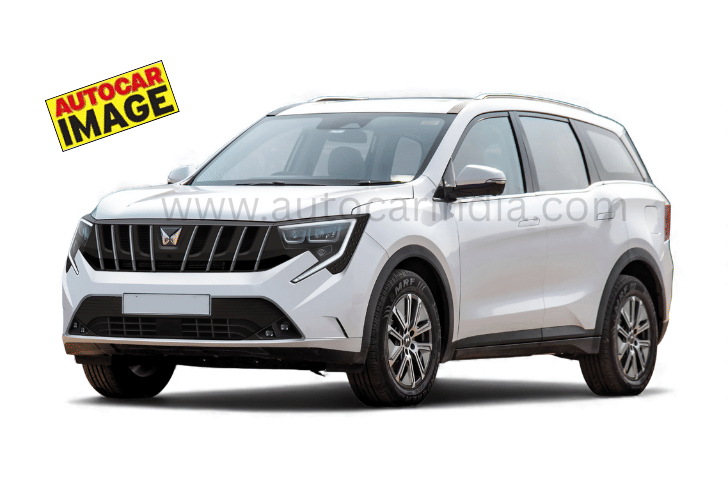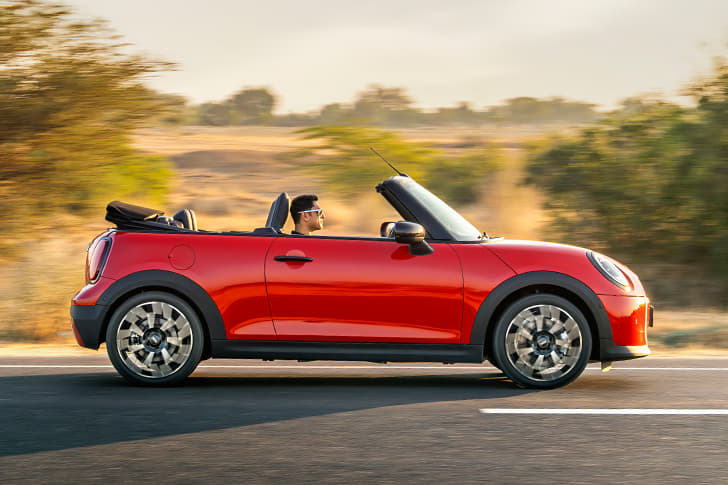This may be a large hatchback, but there is a cheeky cuteness about the design of the Fabia. Its tight-fitting roof, friendly smile and large headlamps are cleverly designed and make the car look far more compact and agile than it is. Bare statistics, however, show that this car is almost four metres long, longer than even the Ford Fusion, and that’s really saying something. It’s the brightwork that grabs your eye first however.
The large, attractive- looking headlamps are mounted high, straddling the bumpers and bonnet, and Skoda’s chrome bar above the grille works fabulously. Look closer and you’ll see that the chrome reflects the car’s unimpeachable quality and projector headlamps tell you that the cost accountant’s scalpel has not cut in here. Like the new Mini, the cabin is inset from the flanks of the car and the roof tapers towards the back. The styling of the rear is quite conservative.
Under the skin, the Fabia is built on an updated and largely new platform that will be shared between other Volkswagen Group companies. The new Volkswagen Polo will also be built on this PQ25 platform, but Skoda, part of the VW Group, get use of it first. The highlights of this chassis include a very sophisticated front MacPherson strut suspension, a stoutly-built lower A-arm and a non-independent rear. The three-part sub-frame at the front of the car decouples the suspension noise and vibration from the body of the car, and the electric steering uniquely uses hydraulic assistance when needed.
For India, Skoda has raised the suspension and retuned the springs and dampers in what it refers to as its ‘rough road’ package. Ground clearance is up to 146mm, and Skoda has also provided a three-part metal plate underneath the car for protection. The car we tested came with ABS and airbags too.
Climb into the Fabia, thud the characteristically-solid doors shut and you are in an environment that feels alien for a hatchback. The maturity of the design, upmarket feel, high levels of quality, and the way the doorpads have been built all give you the impression that you’re behind the wheel of a 10 or 12-lakh rupee car. The insides actually look and feel better than those of its more expensive and larger cousin, the Octavia and that’s no exaggeration. There is not a cheap-looking plastic button in sight (okay, the AC knobs aren’t great), everything works with a solid, slick feel and what completes the picture are the top-class quality and colours. Particularly cool-looking are the dials and doorpads of the car, both designed delightfully.
There is plenty of room for tall drivers, with lots of seat travel (there’s more legroom here than in a Fusion), seat height is adjustable and you can adjust the steering wheel for reach and height as well. This makes a big difference to comfort behind the wheel and you can drive for hours without feeling any sense of fatigue. Still, there were some things we weren’t too impressed with. The steering wheel feels oversized, lateral support on the seats isn’t great, the seats not holding you as firmly as they should, and electronic climate control console should have been added as well.
Passenger space at the rear of the Fabia, however, is generous, the long 2462mm wheelbase providing more than sufficient legroom to seat six-footers. There is decent space in the footwell too and thigh support is good, but the seatback is a little too vertical. Overall, however, comfort levels on the rear bench seat are quite good for a car of this size. And then the cloak of hush the Fabia throws over you with its super insulation just goes to add to the feeling of comfort.
Storage space at the front is also generous. The central console has cubbyholes and cupholders, the doorpads can take a full-sized bottle and there is a clever rubberised band to hold items in neatly. Both gloveboxes are tiny and oddly shaped however and don’t hold very much.
Not so the boot which, at 300 litres, is frankly massive. There is a clever parcel tray at the rear as well that can be placed at two levels for added flexibility.
Equipment levels, as expected, are high. You get powered mirrors, windows and doors, airbags for driver and passenger and an MP3 audio system with an auxiliary socket for your iPod or similar device. And the four-speaker music system on the car we tested played loud and very clear, with a strong mid-range, but rear speakers were strangely missing. Also very useful is a trip computer that tells you how efficiently the car is using its fuel in real-time, refreshing every few seconds.
Powered by a 1422cc, direct-injection diesel motor that allows Skoda to pull an excise sop, the Fabia delivers adequate performance. The motor is actually a familiar one, this three-cylinder unit is the Skoda Laura’s motor minus one cylinder. Using two valves per cylinder and a fixed geometry turbo, this motor uses Volkswagen’s Pumpe Duse method of diesel injection, meaning no common rail system. PD engines use one fuel pump per cylinder and as a result the responsiveness of the motor is very strong. What you get is very high injection pressure and this means an instant increase in engine speed and power delivery as soon as you hit the accelerator. But this sudden increase in pressure also leads to a high amount of diesel clatter as the individual pressure spikes are very sharp.
Like the motor of the Laura diesel, clatter from cold is quite high and most of it remains even when the motor is warm. Responses to the throttle are also not lightning-quick below 2000rpm, some degree of lag present. Still, in city traffic, the Fabia’s large cylinders have enough pulling power, even through the lag, and the Fabia acquits itself reasonably well.
Once past 2000rpm, the Fabia is no slouch. The engine now responds strongly, power delivery after that first spike is linear and the Fabia pulls and pulls. Power doesn’t tail off like other diesels and the strong midrange and top end help it to cover the 0-100 sprint in a decent 14.9 seconds, a second shy of the Swift. Then despite being a three-cylinder motor, the inherent thrum of a three-cylinder is reasonably well suppressed. However, overall, the motor remains the least impressive part of the Fabia package.
The slick, light gearbox is another matter entirely. Totally brilliant and even at times addictive to use, this gearbox and linkage is the one you want to put in a box and carry with you from car to car. Very positive and light, it slots in without fuss or much effort. And we even liked the lip on the gear lever
that helps when you shift to gears in the lower half of the shift H. As expected from any Skoda,
the Fabia proved to be very efficient. Travelling 14.1 kilometres a litre in city conditions and an amazing 18.5 kilometres a litre on the highway. To put it in perspective, the Fabia is among the most efficient cars in India.
Another area the Fabia puts in an exemplary performance is ride and handling. The suspension has been raised for India, and sometimes this results in a less-than-perfect package. Not in this case.
The tall springs, wide rubber and perfect damping results in the most pliant ride ever witnessed on a hatchback. Very few shocks filter in from the road and all but the largest bumps are dealt with noiselessly. Then, the submarine tight sealing of the Fabia also isolates superbly you from outside noises and vibrations, much more than any car of its size has a right to. Ride comfort is also helped due to the high levels of stiffness on this all-new VW-based chassis.
Up the speed and all that absorbent compliance miraculously does little to mess up the fine sense of balance this car possesses. The car still rides flat at high speeds, only pitching a tad over long horizontal bumps. And straightline stability is rock-solid too, the Skoda providing masses of confidence to the driver. It’s the sort of car you can be comfortable doing over 140 kilometres an hour in, just one hand on the wheel. And then the steering is very direct and delivers generous feel. The key is that although this is an electrically-powered steering, it receives assistance from a hydraulic pump when necessary. This ‘hybrid’ steering system as a result gives you the efficiency of an electric system and the feel normally associated with a hydraulic unit.
Add the super steering, the generous grip from the 185 tyres, the high levels of composure and stability, the strong brakes and fantastic gearbox and you have a car that is a treat to drive on a winding road.
The strong brakes give you fantastic confidence on the way into the corner, getting the car into the right gear is a treat with the slick ’box and though you need to wind on a lot of lock to get the Fabia to turn in, the composure of the chassis is so high that more often than not you find the Fabia with plenty of grip in reserve. No, it does not possess the power to be genuinely quick, but the Fabia is still loads of fun.









































